Rapid Prototyping Aluminium advantages and key applications
Rapid prototyping aluminum immediately creates a physical part directly from its CAD model data using different manufacturing process. Rapid prototyping aluminum can be used at any stage of the product development cycle for any sub-components or components. Prototyping can be repeated different times along the new product design process using the test data to get the desired part.
Main purpose of rapid prototyping
The objective of rapid prototyping is to get starting feedback, refining the design, and meet all the needs of the users.
Mainly, the process of rapid prototyping contains the 3 steps which are testing, prototyping, and refining. In any business or company, the designers use this on different stages in order, to better their solutions which are based on the prototyping results and the feedback which they obtain from the clients or users.
Under this, the designer uses the new techniques and checks them, and based on the feedback make changes until the wanted product is not develops or ready. They work until they get right feedback from the client and make changes with their new designs and ideas.
Why is rapid prototyping aluminium important?
Companies need to introduce and develop new products quicker to remain competitive in this quick-moving modern-day consumer market. Since quicker product development and technology innovation are important to a company’s success, rapid prototyping aluminium becomes the most important element of new product development. of course some of them you can use plastic rapid prototyping to replace the aluminum prototype.
Rapid prototyping aluminum gets the following features:
- Quicker new product development
- This will play an important role in the process of creating successful products because it quick up the new product development process
- Final stage product verification against business objectives and technical requirement
- Early-stage design/concept validation of the fit, form, and function of the design
- It permits functionality testing to test the objectives of the idea and to finalise the item specification.
- The prototype gives the client, end-user, customer, and user participant’s hands-on user experience to get feedback.
What are the stages of aluminum rapid prototyping?
Design creation: Using CAD program, a digital 3D model of the object is created. This stage is important for laying the groundwork for the prototype.
Data preparation: The CAD model is processed and changed into a format perfect for the picked rapid prettying technology, generally an STL file, STP file, or IGS file.
Machine setup: The quick prototyping machine is calibrated, prepared, and loaded with the right materials, whether resin, plastic, or metal powders.
Prototype building: The machine constructs the prototype layer by layer, adhering to the features of the CAD model.
Post processing: After the rapid prototyping aluminium build process, the prototype generally needs post-processing to get the wanted surface finish or mechanical features. This can contain painting, sanding, tapping, or assembly.
The importance of rapid prototyping aluminum in manufacturing lies in its capability to immediately produce a physical object from a digital design. The capability is not just about speed, it also provides a tangible way to evaluate and refine a products design in the start stages, making the process more affordable and efficient.
What are the advantages of aluminium rapid prototyping?
Aluminum rapid prototyping is largely used in a big range of industries in rapid prototype manufacturing, as it gives many benefits.
High speed
High speed is one of the key benefits of rapid prototyping aluminum. It shortens the production time to weeks or days. Traditional manufacturing techniques like CNC machining, high pressure die casting, forming and joining is used build a part while metal prototyping with 3D printing does not need new tooling to make a product. Rapid prototyping aluminum can shorten the go-to-market time so the new items can be launched in the market immediately.
Parts consolidation
Aluminum prototyping simplify the complex parts and decrease the quantity of the parts. For example, it can decrease an engine with forty parts to ten parts. It is an achievement for designers because it provides chances to create better parts.
Design flexibility
Rapid prototyping permit to create hard design. If the prototype designs needs rework, it can be performed easily done in CAD model.
Affordable
An aluminum prototype with 3D printing is an affordable technique as it does not need tools or dies. It shortens the development time. Manufactures can make a prototype in the wanted material before running into big production to test the feasibility and performance of the prototypes.
Applications of aluminum rapid prototyping
Nowadays, plastic or metal parts can be prototyped and manufactured immediately. Full-color prototypes can be created as well. Using computer data, manufactures can apply rapid prototyping techniques such as selective laser sintering, stereolithography (3D printing), color jet printing, fused deposition modeling, direct metal printing, and even CNC machining options.
Various 3D printing and rapid prototyping techniques permit concept models to be created. A physical concept model can communicate and demonstrate ideas to engineers, designers, and stakeholders, more easily than a virtual one can. Functional prototypes can be created, adding every design detail and permitting for extensive testing before complete production is scheduled. From the fit of parts to the function and manufacturability of an item, all aspects of it can be assessed. Learn more about Prototyping Machine Shop
When a working prototype is accessible, manufactures can determine whether they have achieved the visual design and functionality they expected. They also access the economic feasibility of moving forward with production. The process is used to making everything from simple plastic or metal parts to components for electric vehicles, to computer circuits.
Pros
- When you use it then it will decrease the time of development and design.

- The use of this one can decrease the cost of full development.
- This can evaluate human ergonomics and factors
- It is permitting functionality testing.
- This improved and increased user involvement
- With the help of this, the elimination of risk occurs.
Cons
- It will add some primary cost
- It needs the labor who is professional is using this
- Sometimes there is an accuracy problem
- With this system, one can use limited materials only.
- Not all prototyping are economical some of them are costly
- Sometimes the material properties such as strength and surface finish do not match
We’re glad you found GC Precision Mould here. It’s the best place in China to get outstanding die casting and mould making services. those services include Plastic moulds, aluminium die casting mould, and a wide range of die-cast parts from metals like magnesium, zinc, and aluminium.
We are GC Precision Mould, and our goal is to offer the best services for anodized metal parts and other casting goods. Our professional engineers and workers have over 15 year of experience in the die casting, surface finish, and mold manufacturing, with all of those professional factors we can make sure that every part we make not only meets but also exceeds the highest standards of quality and care.
Our products are used in lots of different industries, like cars, consumer electronics, medical gear, and heavy machinery. We spend a lot of time with our clients to fully understand what they need. This lets us make products to suit our customers needs
We can help you whether you need a single plastic mould or a whole die casting production line. Get in touch with us to get the best deals and service for your job. Die casting China for aluminium parts that has been anodized or China mould maker for injection-molded goods that have been painted with spray paint. We care a lot about your success, and we can’t wait to help you with your steel die casting jobs.





0 Comments